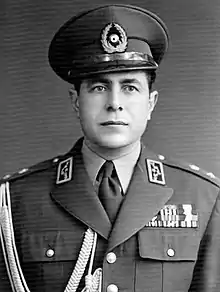Mohammad-Vali Gharani
Mohammad-Vali Gharani (Persian: محمدولی قرنی) (1913–23 April 1979) was an Iranian military officer. He was born in Tehran in 1913.[1] He graduated from the Officers' Academy and the War College.[1] In 1950 he joined the Imperial Army and was promoted to the rank of colonel.[3] Then he was appointed to Rasht as a garrison commander.[3]
Mohammad-Vali Gharani | |
|---|---|
 | |
| Born | Seyyed Mohammad-Vali Gharani 21 March 1913 |
| Died | 23 April 1979 (aged 66) Tehran, Iran |
| Cause of death | Assassination |
| Resting place | Fatima Masumeh Shrine, Qom |
| Alma mater | Officers' Academy War College |
| Conviction(s) | Disobeying orders, Attempting to overthrow the throne (1958); Undermining national security (1963)[1] |
| Criminal penalty | 3 years in prison (1958); 2 years in prison (1963)[1] |
Date apprehended | 1958–1961; 1963–1965 |
| Military career | |
| Allegiance | Iran |
| Service/ | Imperial Iranian Army Islamic Republic of Iran Army |
| Years of service | 1930–1958; 1979[1] |
| Rank | Major general, Lieutenant general (as Chief-of-Staff)[2] |
| Commands held | Second Bureau[1] Chief-of-Staff |
| Battles/wars | 1953 Iranian coup d'état[1] 1979 Kurdish rebellion |
| Other work | Member of the Council of the Islamic Revolution |
By August 1953, Gharani was commander of the Rasht Brigade and loyal to the Shah. He met with Ardeshir Zahedi and helped 1953 Iranian coup d'état. Following the coup, he was promoted to vice Chief-of-Staff.[1] In 1957, when SAVAK was established, he reportedly was a candidate to take office as head of the newly established secret service.[1] Gharani however had become increasingly critical of regime due to 'endemic corruption' over the past years, unbeknownst to the authorities.[1] He planned a coup d'état against the regime which was exposed, leading to dishonorable discharge in 1958.[3] He was imprisoned twice in 1958 and 1963.[2]
Gharani served as the first Chief-of-Staff of the Iranian Army after the Iranian Revolution, from 12 February 1979[2] to 27 March 1979, when he was forced out.[1] He was assassinated on 23 April 1979 by Forqan Group.[2]
References
- Abbas Milani (2008). Eminent Persians: The men and women who made modern Iran, 1941-1979. Vol. 1. Syracuse, N.Y.: Syracuse University Press. pp. 445–450. ISBN 978-0815609070.
- Nikola B. Schahgaldian; Gina Barkhordarian (March 1987), The Iranian Military Under the Islamic Republic (PDF), RAND, ISBN 0-8330-0777-7, retrieved 15 January 2017
- Mark J. Gasiorowski (November 1993). "The Qarani Affair and Iranian Politics". International Journal of Middle East Studies. 25 (4): 625. doi:10.1017/S0020743800059298. S2CID 154722900.
